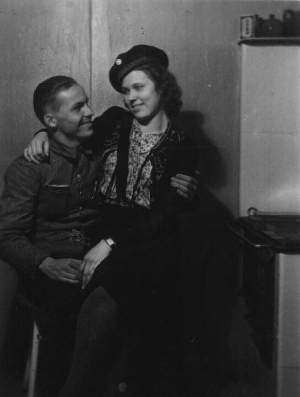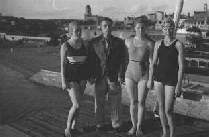Last Updated May 9, 2013

![]() The story begins in a far away land
called Karelia. The man's name is Antti, and the young woman's name is Meeri.
They wanted to settle down and make a home in Karelia, but one winter's day in
1939, strangers from a land not so far away came to take their land and dreams
away. Against all odds, like his forefathers have done for hundreds of years,
Antti went to drive them away. This is their story.
The story begins in a far away land
called Karelia. The man's name is Antti, and the young woman's name is Meeri.
They wanted to settle down and make a home in Karelia, but one winter's day in
1939, strangers from a land not so far away came to take their land and dreams
away. Against all odds, like his forefathers have done for hundreds of years,
Antti went to drive them away. This is their story.
![]() Tarina alkaa kaukaisessa satumaassa jonka nimi on Karjala. Miehen
nimi on Antti ja naisen nimi Meeri. Heillä oli haaveita tehdä Karjalaan kotinsa.
Mutta eräänä talvipäivänä vuonna 1939 tuli Karjalaan vieraita miehiä, ei kovin
kaukaa, ottamaan heidän maansa ja haaveensa pois. Ja kuten muinaiset esi-isät
satoja vuosia olivat tehneet, Antti meni ajamaan niitä pois. Tämä on heidän
tarinansa.
Tarina alkaa kaukaisessa satumaassa jonka nimi on Karjala. Miehen
nimi on Antti ja naisen nimi Meeri. Heillä oli haaveita tehdä Karjalaan kotinsa.
Mutta eräänä talvipäivänä vuonna 1939 tuli Karjalaan vieraita miehiä, ei kovin
kaukaa, ottamaan heidän maansa ja haaveensa pois. Ja kuten muinaiset esi-isät
satoja vuosia olivat tehneet, Antti meni ajamaan niitä pois. Tämä on heidän
tarinansa.



The Soviet Union attacked Finland in 1939 and after the Winter War, Finland lost most of Karelia. When the Soviets resumed hostilities against Finland, the Finns continued the Winter War, which was called the Continuation War. By the end of August 1941, all the territory lost in 1940 had been reconquered, but the Finnish offensive was kept up until the beginning of December, by which time the greater part of East Karelia (pictures of Lottas, women's corp, at Karhumäki, Lake Onega) had been secured. This area was considered to be possibly valuable as a bargaining counter in peace negotiations. Securing the islands on lake Laatokka (Ladoga), Europe's largest lake, continued into the fall of 1941 and was the job of the Laatokka Defence forces and the Laatokka Navy.
Finland was in a position where it could not, for fear of allied reprisals, cut the Leningrad supply line south of the river Svir, across the Laatokka ice. Lend-Lease war supplies from the United States poured into Leningrad. While this helped save Leningrad, it accelerated Finland's own fate.
In 1941 Antti was back in the army, this time as a sergeant. By September of 1941 the Finnish army had taken all the territory north of Lake Laatokka (Ladoga), Europe's largest lake that Finland shared with Russia prior to 1939. The army continued into Eastern Karelia (Äänisen aallot - a wartime song about Äänisjärvi = Onega). Antti's unit, which was part of the Laatokka Naval forces, was given the task of taking back the islands in Lake Laatokka that had been taken over by the Soviet Union. From the north end of Lake Laatokka, at Lahdenpohja, they commandeered a number of clinker-built wooden fishing boats and refitted them with guns. Other boats were brought in from Finland by train. They were used to remove the Red army from Ladoga, the ancient Karelian people's lake, the eastern half of which was ceded to Russia in 16th and 17th century wars. So badly did the Russians want this land, that they even moved the converted Karelians away to Tver, near Moscow in the 17th century, "to protect them from the Lutherans." But, the Finns are a difficult people to come and take anything from. The tradition continues.


 |
Läskelän Tukikohta 1 Läskelä Base 1 |
 |
Läskelän Tukikohta 2 Läskelä Base 2 |
 |
Kukkapään Tukikohta Kukkapää Base |
 |
Tykkivene Haapaniemi Gunboat Haapaniemi |
18.6.1941, Antti joutui takaisin armeijaan 2. armeijakunnan esikunnassa ja toimi radistina. Hän oli jo 26.6.1940 reservin alikersanntti ja nyt Laatokalla kersantti - vaikka virallisesti vasta 21.10.1944. Syyskuuhun menneessä Suomi oli jo ottanut takaisin alueet jotka Venäjä oli ryöstänyt vuonna 1940, ja pojat jatkoivat matkaa Itä-Karjalaan. (Lotta kuvia Karhumäeltä, Äänisjärvi) (Kuuntele Äänisen aallot) Antin (Laatokan Puolustus) Laatokan Laivastojoukkuelle annettiin tehtävä poistaa Ryssä Laatokan saaristosta. Lahdenpohjasta ja Läskelästä Antin joukkue valitsi veneitä, asetutti 3pdr/47mm tykit niihin, ja lähtivät Laatokalle, esim. Sortavalaan, Valamoon, Rahmansaareen jne. Laatokan kartta Monia saaria venäläiset eivät olleet miehittäneet, mutta yhtä saarta - Rahmasaarta, (elikä Rahmansaari) venäläiset halusivat puolustaa erittäin lujasti. Monet veneet, joista Antti otti kuvia paikanpäällä, ovat myös Suomalaisissa Rahmasaaren taistelun aikakirjoissa. Kun kirjoittaja luki niistä viime aikoina, hän meni katsomaan onko Antilla kuvia niistä. Onneksi sielä näky olevan monta: esim. mv. 14, 1, 37, Kukkapää, tyk.v. Haapaniemi, tyk.v. Mantsi, ym.
Veneet saapuivat Rahmasaareen aamulla aikaseen, syyskuun 6/7 päivä. Antti kertoi että hänen "Lähde" osaston ryhmässä oli kahdeksan venettä joissa oli jokaisessa yksitoista miestä. Kauempana Laatokalla olevien tykkiveneiden sekä muissa saareissa olevien patterien esim. Maunun tulituksen jälkeen veneet alkoi hyökätä saareen eri puolilta. Hyökkäyksessä oli kaksi porrasta joilla oli puolen tunnin väli, ankarassa saaresta tulevassa tulituksessa. Korpraali Antin veneessä haavoittui niskaan. Sen jälkeen, vene hajosi, ja Antti käski kaikki miehet veteen, vaikka ei ollut paljon vaihtoehtoa. Sen jälkeen, kaksi Antin miestä pääsi rantaan heittämään muutaman kranaatin, ja ryssät antautuivat. Kolmen vuorokauden taistelun jälkee 103 Ryssää oli saanut surmansa ja loput otettiin vangiksi. Taistelu ei ole ihan niin yksinkertainen kun Antin muisti julkaisee. Olavi Väliahon kirja, Laatokan Puolustajat Karjalaan, kertoo monesta Laatokan taistelusta, josta oli mukava lukea Rahmasaaresta. Antti puhui paljon vangeista. Hän jutteli heidän kanssa ja tarjosi tupakkaakin. Hänen mielestä nämäkin oli ihmisiä, ja hän kohteli heitä sen mukaan. Aikakirjojen mukaan on hieman erillainen, monimutkaisempi kertomus. Antti kertoi että hänestä ei ole jäljellä paljon tietoja valtiolla - ehkä tuhoutunut. Nämä seloistukset eivät täydellisesti kerro mitä tapahtui; ei ole esimerkiksi löydetty kun vasta nytten (Valpas) mitään hänen osallistumisesta Rahmasaaren taisteluun, ja ei mitään hänen haavoittumisesta.

Seuraava on Heikki Nurmion Jääkärien Marssista:
Siinä taistelussa Antti haavoittui räjähtävästä luodista. Lisäksi kylmä vesi vahingoitti Antin verisuonia jaloissa ja hän sai kärsiä loppuelämänsä jalkavaivoista.
Island-Hopping on Lake Laatokka

An invasion plan was drafted and implemented. They approached the island at daybreak on September 6/7, 1941. Antti's group was in eight fishing boats with eleven men to a boat. The assault was preceded by shelling by heavy guns, and covered by gunboat Kukkapää under Chief Petty Officer Lauri Tolvanen and several other gunboats. As they approached they came under heavy machine-gun fire so they backed off and came in from another direction. His orders were to go straight in (Antti said as his hand made a slicing motion, showing how he was ordered to go in) dispite the fire.

Once again they came under heavy machine-gun fire and the corporal manning the forward machine gun in Antti's boat was hit in the neck and fell back into the boat. The water around the boats boiled with machine gun fire. Antti's boat started to break up, so he ordered all his men overboard. The water was not deep and they did not have much trouble making it to the shore, but they were pinned down at the waters edge. Antti spent several hours in the cold waters of Lake Laatokka. At one point he came into a snipers gunsight.
Fortunately, the bullet struck a branch of a tree just in front of his face. The bullet exploded on impact and sent tiny fragments of shrapnel into his face and into the backs of his hands. His hands were close to his face because he was holding his rifle in the "ready" position.
He was in a bad situation. They were pinned down and his corporal was wounded. He also lost another man to machine-gun fire. Antti's feet were freezing in the water, and he was bleeding from the face and hands. Two of his men eventually managed to work their way around to the side of the Soviet position and threw a couple of hand-grenades. For reasons that Antti does not understand, his life was saved by a Russian lieutenant who decided to surrender. To the best of Antti's recollection, this is how the events folded. The Finnish chronicles on the Rahmasaari Battle, are a lot more definitive regarding timeline. There were several other detachments involved in the battle which lasted three days, with attacks from various sides of the island. Rahmasaari Battle Chronicles.
It took the Finns several days to dislodge the remainder of the Soviet troops. They fought very fiercely and many of them died. The Captain looked after Antti's wounds until they could get him back to the Kyysaari.
The Russians have always wanted more land, that is their nature. This is not the first time the Finns have had to defend their land.

![]()
![]() Rahmasaari Battle
Chronicles.- Rahamasaari battle in which Antti participated.
Rahmasaari Battle
Chronicles.- Rahamasaari battle in which Antti participated.
![]()
![]() Goodbye Karelia - Hyvästi Karjala - Antti's story
Goodbye Karelia - Hyvästi Karjala - Antti's story
Lähteet - Bibliography